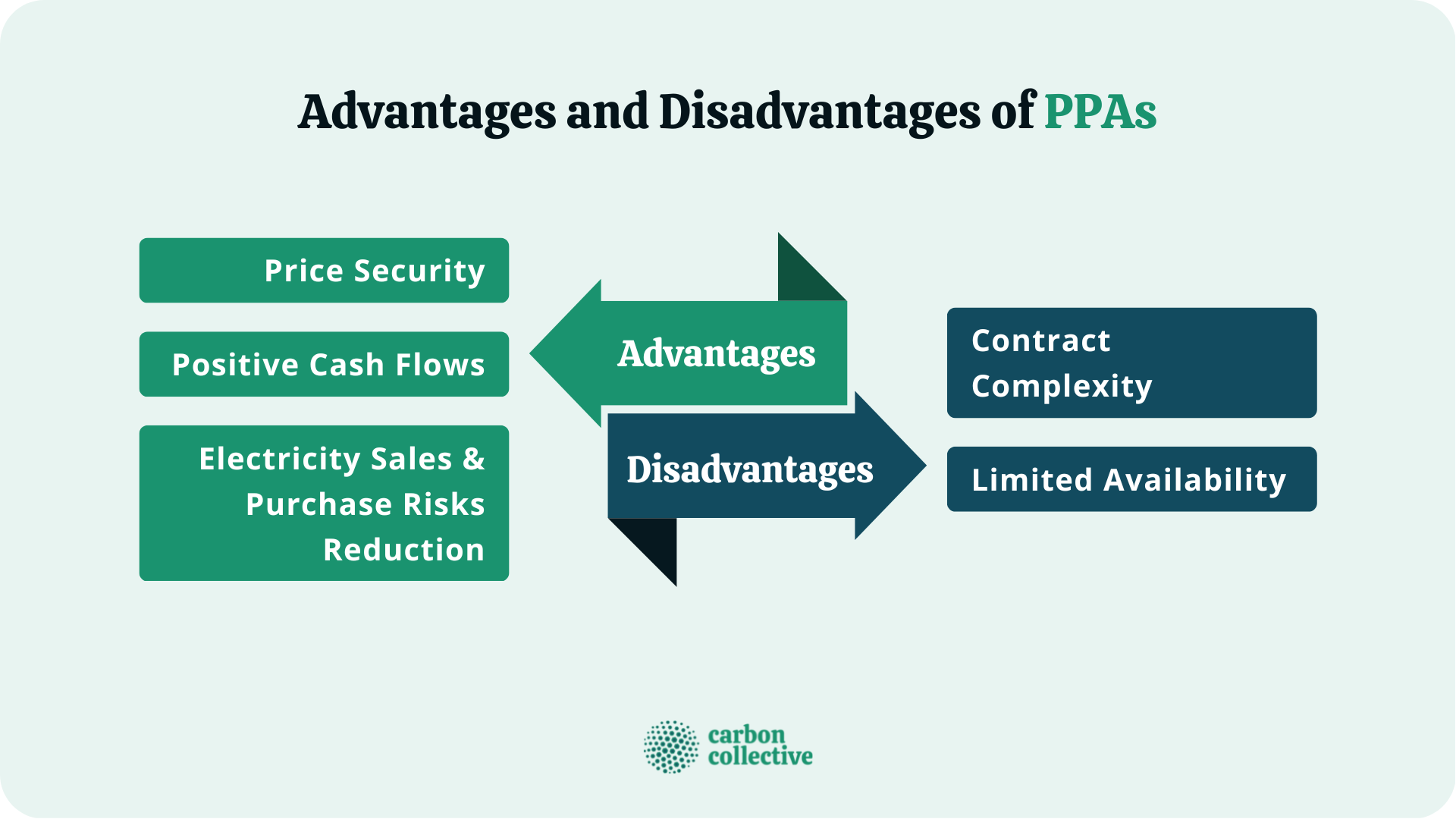What Are Power Purchase Agreements (PPAs)?
Power purchase agreements (PPAs) are a contract between two parties: the buyer and seller.
One party (the buyer) wants to buy electricity that the other (the seller) is willing to sell. The seller produces a set amount that the buyer purchases.
The contract, or agreement, is long-term and typically lasts 15-25 years. This gives the seller an opportunity to make investment plans while also allowing the buyer to benefit from economies of scale that come from purchasing energy over a longer period.
How Do PPAs Work?
The buyer and seller agree on the terms of the agreement. These may include price, length of the contract, the amount produced or sold each year, fuel used, penalties, and termination.
The buyer's responsibility is to purchase the energy at a fixed or negotiated price. The purchase price is generally lower than retail rates due to the bulk quantities purchased.
The seller's responsibility is to produce and provide the set amount. Sellers may provide solar panels on a home, wind turbines in a rural location, or purchase green energy credits that offset the power otherwise generated from fossil fuels.
The PPA is best understood as an electricity hedge. It locks in a fixed rate with predetermined fixed costs for buying and selling electricity. This allows both parties to know what they are agreeing to before making any agreements.
After drafting the terms of the PPA, an application will then be submitted to the state public utility commission (PUC). The PUC reviews the application and approves or denies it. Approving the application facilitates the agreement between buyer and seller.
Types of PPAs
Two different types of PPAs can be found in energy markets: physical and synthetic.
Physical PPAs
A physical PPA is where a seller provides a specific number of megawatt-hours each year for a set price over a set period.
This type of agreement is more common than a synthetic PPA. It locks in a guaranteed quantity and price. Hence, it eliminates worries about future market conditions changing the agreed-upon value/price.
Physical PPAs split into on-site PPA, off-site PPA, and sleeved PPA. A common attribute is the fixed quantity of electricity agreed in the PPA. The difference lies in how electricity is supplied.
On-Site PPA
An on-site PPA requires the physical proximity of the production facility and the buyer. This means that they must be located within proximity of one another. They may also share a power grid that allows energy to flow between locations.
Installation and parameter details of the PPA are based on the amount of power required for the production facility.
Off-Site PPA
An off-site PPA allows for a set number of megawatt-hours to be produced even if the energy production facility is not near the buyer.
The path that electricity takes to reach its destination can often involve different organizations, such as transmission networks, generators, distributors, retailers/aggregators/brokers, and bulk suppliers.
A centralized location is required so that all parties can access relevant information about producing electricity.
In contrast with on-site PPAs, off-site PPAs are more flexible. This is because they allow energy to be produced at multiple locations, which can lead to higher revenue.
Sleeved PPA
A sleeved PPA is the process of an off-site company purchasing capacity from another power-producing facility so that they may match their production profile with the consumer demand.
This type of agreement requires both companies to cooperate to provide reliable energy. The seller has almost full control over their output. The buyer sets the conditions for when and if sales occur.
Price risk is transferred from one party to another through this contract. Since PPAs are based on long-term contracts, these types of agreements are ideal for the buyer. This is because the seller is responsible for bearing any risk due to price volatility.
Synthetic PPAs
A synthetic PPA functions similarly to a physical one in terms of guaranteeing access to power. The difference is that there are multiple buyers, sellers, and sources of electricity involved throughout different trading platforms.
These trading platforms often have associated gas markets that are also very liquid with several buyers and sellers.
Even though there are multiple sources of electricity, they are not necessarily connected at the same location. This means that the supply is not as dependable as a physical PPA. However, such an agreement can be created just as easily as a physical one.
A synthetic PPA is ideal for those who want to procure energy but do not have an available source. It is also ideal for those who want to take advantage of low prices. It affords them lesser risks than those that are contracted under their specific agreement. These risks could include price fluctuations and counterparty default.
Advantages of PPAs
Below are some of the advantages associated with PPAs:
Price Security
The cost of electricity purchased through a PPA is fixed as opposed to buying it through other sources, such as the spot market. Since electricity prices derive from the supply and demand of customers, price security is assured throughout the contract term.
Positive Cash Flows
PPAs have been found to offer positive cash flows because they can provide protection from wholesale price fluctuations. They also provide a steady long-term revenue stream for a fixed period.
This predictability allows companies to plan better for their future expenses and make use of growth opportunities, which should drive shareholder value.
Electricity Sales and Purchase Risks Reduction
PPAs reduce the risks of securing a power supply by clarifying costs. This should lead to higher operating margins for electricity sales and cost savings in relation to purchased power.
Disadvantages of PPAs
While we do see numerous advantages associated with PPAs, there are also disadvantages, such as:
Contract Complexity
The contract required for a PPA is more involved than other contract types because it goes through different companies before reaching its final destination.
This means that there could be multiple provisions and terms that may impact you financially or operationally. These provisions include updates, amendments, and negotiation costs, especially if the agreement has to remain flexible.
Limited Availability
PPAs require a substantial amount of planning and development time. This limits availability from other sources if companies have not secured long-term contracts.
Also, because laws regulating PPAs vary by state, some states may have laws that do not allow for this type of arrangement.
Final Thoughts
Overall, PPAs can provide many benefits for both companies and investors. It is a good alternative for those who want to reduce price volatility or the risks associated with other options.
The role of a power purchase agreement is to define all obligations and expectations between the parties involved.
The primary difference between PPAs and other power supply contracts is that PPAs do not require one entity to own, operate, or build any type of plant. Therefore, this arrangement will allow them access to electricity while limiting their risks.
In comparison to other models, such as public utilities, the buyer would be the utility, and the third-party generating entity would be a power plant or farm.
This type of agreement benefits both parties. It allows buyers to diversify their energy portfolio by locking in a price for electricity. It frees them from worries about risks, such as counterparty default and commodity prices going up. It also provides sellers a steady long-term revenue stream for a fixed period.
The key is to understand your situation before seeking out a PPA so you can fully take advantage of all benefits while mitigating any risks.
FAQs
1. Why would a company want a PPA?
Companies can reduce their risks by securing supply through PPAs because fluctuations in commodity prices are mitigated due to fixed costs. Companies also benefit from a stable power source without having to manage infrastructure or bear the costs associated with building new capacity.
2. How do parties in a PPA agree on a price?
The simplest method is to fix prices based on previous costs or forecasts adjusted for inflation. Another popular option is to base rates off daily peak energy rates, which change based on supply and demand levels. A third option is using options contracts where payouts will be made if market conditions meet certain specifications.
3. What happens when one party wants to end the PPA early?
Most PPAs include provisions allowing either party to terminate at any time with terms agreed upon beforehand. The main thing to avoid is early termination fees if unforeseen changes happen outside your control.
4. What are the advantages of PPAs?
Your business can obtain power without having to invest in infrastructure or bear costs associated with building new assets. PPAs give companies access to stable energy while limiting exposure to commodity price risks. Another advantage comes from tax benefits because no ownership stakes are transferred from one party to another.
5. What is a disadvantage of a PPA?
These arrangements can be complex and lead to higher transaction costs.

